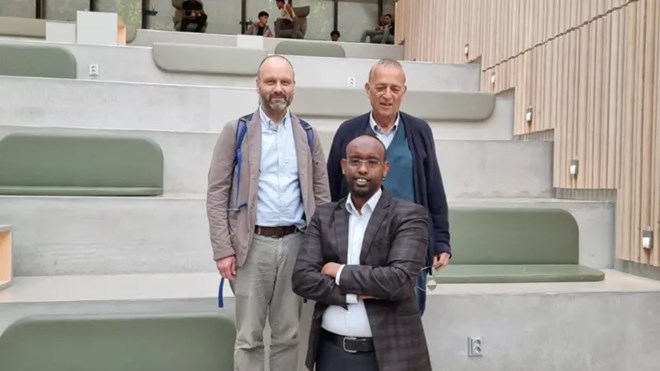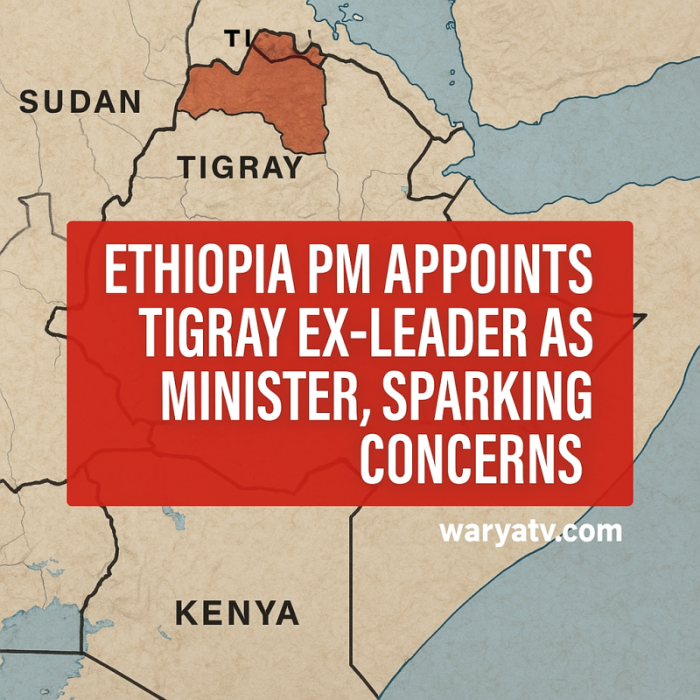Commentary
Preserving Somali Linguistic Heritage through Swedish Collaboration

The collaboration between the University of Gothenburg in Sweden and Somali scholars represents a groundbreaking effort to preserve and deepen understanding of the Somali language, a critical component of Somalia’s cultural and historical identity. This initiative goes beyond traditional linguistic studies, aiming to scientifically analyze and codify Somali’s complex grammatical structure while addressing broader challenges faced by African languages.
Somali Language in Focus: A Scientific Lens on Tradition
The Somali language, with its intricate grammar and rich oral traditions, serves as a cornerstone of Somali identity. Efforts at the University of Gothenburg to dissect and study its core mechanics are vital in preserving its legacy. By examining phrases like “Lala socday” (“It was accompanied”), researchers delve into the interplay of syntax and subject-verb modifiers, revealing the language’s nuanced structure. This level of analysis elevates Somali from mere spoken communication to a subject of scientific inquiry, highlighting its sophistication and depth.
The collaboration is unique in its approach. Somali students and scholars are taught the academic intricacies of their language by Swedish instructors who specialize in its structural framework. This method not only bridges linguistic gaps but also ensures that native speakers gain a comprehensive understanding of their language from a scholarly perspective. The notion that fluency alone does not equate to scientific mastery underscores the value of these efforts.
A Treasure Trove of History: Manuscripts and Legacy
One of the most compelling aspects of this initiative is the study of ancient Somali manuscripts housed at the university. These documents, some centuries old, provide invaluable insights into the language’s historical evolution and its role in shaping Somali culture. Collaborative analysis between Somali and international scholars ensures that these texts are studied with cultural sensitivity and academic rigor.
By preserving these manuscripts and bringing them into the academic fold, the program addresses a pressing challenge: the global neglect of African languages in scholarly discourse. Such efforts position Somali as a linguistic treasure, rich in historical significance and deserving of global recognition.
Challenges and Opportunities for African Languages
The initiative also sheds light on broader issues faced by African languages. Limited scholarly attention and the legacy of colonialism have stunted the development of many indigenous tongues, including Somali. Efforts like those at the University of Gothenburg are critical in reversing this trend, applying scientific methods to give these languages the platform they deserve.
Correcting official Somali government documents is a striking example of the program’s impact. By addressing errors in central and regional government texts, the researchers underscore the importance of linguistic precision in governance and documentation. This practice not only validates the program’s relevance but also enhances the credibility of Somali as a language capable of serving formal and academic purposes.
Bridging Gaps and Building Resilience
The collaboration between Swedish and Somali scholars bridges significant gaps in understanding while underscoring the global value of Somali as both a linguistic and historical artifact. For Somali communities, this initiative represents more than academic inquiry; it is an act of cultural preservation and empowerment.
In ensuring the language thrives, these efforts provide a legacy of resilience, demonstrating that African languages can and should play a central role in the global linguistic and cultural landscape. By combining academic rigor with cultural sensitivity, the project offers a model for preserving other endangered or underrepresented languages worldwide.
As the initiative continues, it promises to not only safeguard Somali’s linguistic heritage but also inspire similar efforts to celebrate and preserve the rich linguistic diversity of Africa and beyon
With files from the BBC Somali Service
ASSESSMENTS
Gunfire in the Gulf: Bulk Carrier Ambushed off Yemen’s Coast

High seas alert as armed boats pursue merchant ship near Aden, reigniting piracy fears and exposing regional maritime chaos.
A merchant bulk carrier is chased by armed boats near Yemen in a dramatic 2-hour incident, reigniting fears of piracy and Houthi insurgency in the Gulf of Aden.
A quiet shipping lane turned into a maritime standoff Tuesday evening when a bulk carrier traversing the Gulf of Aden was pursued for nearly two hours by multiple small, armed boats—an alarming sign that the waters off Yemen are once again boiling with threats.
UKMTO confirmed the incident occurred 100 nautical miles east of Aden, with gunfire reported and the vessel forced into evasive maneuvers toward the Yemeni coastline. Though no casualties were reported and the ship managed to continue its course, the confrontation has set off security alarms across the maritime world.
Who were these armed men? That’s the burning question. While some suspect traditional piracy, analysts at Neptune P2P Group argue the tactics were uncharacteristic—suggesting a more dangerous twist. Could this be a dry run for Houthi-aligned maritime militia? Or a rogue coastal faction flexing its muscle?
The Houthis, fresh off a ceasefire hiatus tied to Gaza, have recently threatened to resume attacks on shipping—especially those with Israeli links. While they’ve stayed silent about this specific incident, the implications are ominous.
What’s certain is this: piracy in the Gulf of Aden never truly died. The brief calm following the 2023 resurgence now seems like a prelude to a new wave of asymmetric sea warfare. The EU’s extension of Operation Atalanta through 2027 suddenly looks like a prophetic move.
And the danger isn’t isolated. From Somali pirates re-emerging to Houthi threats and rogue militias in war-torn Yemen, the Gulf of Aden is becoming a maritime minefield—one gunboat away from full-scale chaos.
The next incident may not end with a safe escape—but a ship taken hostage.
Commentary
China Slaps Trump With Brutal Reality Check as Trade War Turns Global

Chinese state media blasts Trump’s tariff war, accuses U.S. of freeloading on globalization while Xi strengthens Asian alliances.
China lashes out at Trump’s economic nationalism, accusing the U.S. of hypocrisy as global trade realigns. Rare earths, aircraft, and semiconductors are next in this economic war.
Beijing just turned up the heat—and made it personal.
China Daily, the official mouthpiece of the Chinese Communist Party, has delivered a scathing editorial aimed squarely at Donald Trump, telling him to “stop whining” and stop pretending the U.S. is a victim of global trade. “The U.S. is not getting ripped off by anybody,” it declared. “It has been taking a free ride on globalization for decades.”
The insult isn’t just rhetorical—it’s strategic. Trump’s aggressive tariff campaign, which now includes up to 145% duties on Chinese imports, has sparked the fiercest economic duel in decades. But China isn’t retreating. Instead, it’s choking U.S. exporters and fueling regional alliances that sideline Washington altogether.
Xi Jinping’s surprise regional tour, now overlapping with this tariff escalation, is no coincidence. Xi is quietly building what he calls a “strategic alliance of destiny” with Malaysia and ASEAN countries. Translation: Beijing is done playing by Trump’s rules. While the U.S. ratchets up tariffs and threatens new probes into semiconductors, pharma, and rare earths, China is reinforcing control of critical global supply chains.
The stakes? Massive. The Hong Kong postal service just banned packages to the U.S., Boeing deals are stalling, and Chinese firms are moving supply lines away from American manufacturers. Rare earth export bans are already shaking markets, and Beijing’s shadow diplomacy is redrawing global trade corridors.
Trump says, “The ball is in China’s court.” But Beijing just spiked it—with force.
Bottom line: This is not just a trade war. It’s a global economic realignment. And China’s message to the world? America’s time as the global economic sheriff is over—and it has only itself to blame.
Commentary
UK Keeps Feeding Somalia’s War Machine: Another $3.9 Million for Militarized Mogadishu

As the UK pumps millions more into Somalia’s army, Somaliland faces heightened threats while UNSOS fuels an increasingly unstable regional arms race.

The British government just wired another $3.9 million to fuel Mogadishu’s militarization—and Somalilanders are asking: “Who is this war chest really aimed at?”
On Monday, the United Nations Support Office in Somalia (UNSOS) confirmed the UK’s latest cash drop into the Somali Security Forces (SSF) Trust Fund, bringing British support to a staggering $50 million since 2021. The funds pay for food, fuel, medevac missions—and logistics for nearly 19,000 Somali troops, with expansion plans already in motion.
These aren’t peacekeepers. This is a foreign-funded, UN-managed fighting force—trained, equipped, and deployed at a time when Somalia is entrenching its hold on Las Anod, and threatening Somaliland’s borders. Where is this force going? And against whom?
The UK claims it’s backing the fight against “violent extremists.” But that same Somali government just welcomed Turkish military bases, offered Chinese-backed oil deals in disputed territory, and is building an army that doesn’t even control its capital without foreign troops.
The funding also helps facilitate frontline evacuations—a reminder that this isn’t just security. It’s active warfare.
British Ambassador Mike Nithavrianakis proudly called Somalia “a firm friend.” But whose security is being guaranteed? Somaliland’s sovereignty? No. In fact, the very funds flowing through UNSOS could end up emboldening Somalia’s push into contested lands, or worse—into Somaliland territory itself.
And while Somalia’s National Security Advisor promises “transparency and accountability,” the record shows militia infiltration, human rights violations, and chronic misuse of donor funds.
Somaliland’s silence in this equation is dangerous. The longer Hargeisa fails to demand a separate recognition in global security structures, the more millions will be funneled into the very force seeking to erase it from the map.
This isn’t a donation. It’s arming instability.
Commentary
Erdogan’s Ottoman Hustle: How Turkey Is Playing Trump to Crush American Business in Africa

While Trump talks business, Erdogan snatches U.S. oil fields and military contracts in Somalia and Syria—turning allies into proxies and profits.
Trump wants to put America first. But Erdogan wants to put America in check.
As President Donald Trump moves to limit U.S. exposure abroad, Turkish President Recep Tayyip Erdogan is running a global hustle—undercutting American firms, sponsoring proxies, and hijacking U.S. influence from Somalia to Syria.
The latest example? Las Anod—the town Somalia seized from Somaliland in 2023, with China’s blessing. Erdogan didn’t just nod; he sent his oil company. Just months after the offensive, Turkey’s state-owned petroleum giant signed rights to land blocks in Somalia, including the Holhol bloc—once explored by Houston-based ConocoPhillips.
And who’s facilitating the handover? Somalia’s PM Hamza Barre, Erdogan’s new pawn. Barre’s Las Anod visit wasn’t diplomacy—it was resource extraction theater, designed to reward Turkish firms for backing Mogadishu’s illegal annexation of Somaliland land.
This isn’t partnership. This is daylight robbery.
Erdogan has already entrenched himself inside Mogadishu’s airport, where U.S. diplomats operate under Turkish security. He built a naval base, trains Somali forces, and now wants the entire Horn of Africa oil patch—all while selling himself to Trump as a strongman “ally.”
He even married his drone empire into power—literally. Erdogan’s daughter is married to Selçuk Bayraktar, Turkey’s top defense tech mogul. Baykar drones are now exported to Somalia, Syria, and anywhere Turkey wants leverage.
Meanwhile in Syria, Erdogan props up puppet president Ahmed al-Sharaa, who funnels reconstruction contracts to Ankara—not Washington. And in the Eastern Mediterranean? Erdogan is expanding maritime claims, slashing through U.S.-backed gas corridors to grab more sea-based wealth.
Erdogan is not Trump’s partner. He’s his economic predator.
While Trump believes business is the best diplomacy—and he’s right—he’s being played. If America doesn’t wake up, Erdogan will gut U.S. influence across East Africa, the Levant, and the Mediterranean—all while laughing on the phone with Beijing and cashing checks in Ankara.
It’s time for the U.S. to stop the charade, shut down Turkey’s energy grabs in Africa, and back real partners—like Somaliland and Israel—who fight for security, not Ottoman revenge fantasies.

Commentary
Syrian Forces Target Iran’s Secret Arms Routes in Shadow Border War

Iran-backed Hezbollah caught smuggling weapons across Syrian-Lebanese border as new HTS regime fights to cut Tehran’s reach.
A covert war is raging along the 233-mile border between Syria and Lebanon—and at its heart lies a high-stakes battle to cut off Hezbollah’s lifeline.
According to a bombshell Washington Post report, deadly clashes have erupted between Hezbollah militants and Syrian patrol units, as the Iran-backed terror group scrambles to restore its weapons flow after sustaining crippling losses in its recent war with Israel. With arms stockpiles depleted and senior leadership buried under rubble, Hezbollah is betting everything on reopening its old smuggling trails.
But the game has changed.
Syria’s new HTS-led government, which replaced the Assad regime, has vowed to dismantle Iran’s grip on the border. Commanders report sniper fire, ambushes, and smuggling seizures as Tehran tries to reactivate networks buried since the civil war. “They are trying to open gaps,” said Maher Ziwani, a senior Syrian officer, warning that cooperation between Hezbollah and regional clans has blurred any line between criminal syndicates and terrorist cells.
Despite Israeli airstrikes targeting known Hezbollah positions near Qusayr, caches of Iranian weapons are still being uncovered—in shops, schools, and stairwells just miles from Lebanon. “There is a huge stockpile in Syria that Hezbollah is trying to move out,” said Haid Haid, a Chatham House analyst.
Local commanders claim more than a dozen shipments have already been intercepted, but confidence is razor-thin. “I don’t trust the border even 1%,” Ziwani admitted.
This isn’t just a smuggling war—it’s a showdown between a restructured Syria and Iran’s vision of permanent regional chaos. As Israel keeps its sights locked on Hezbollah, the HTS regime may be doing Jerusalem’s dirty work—disarming Iran’s proxy, one gunrunner at a time.
Commentary
Ethiopia’s PM Appoints Ousted Rebel Leader, Risking New War Flashpoint

Getachew Reda’s shock return as Abiy’s advisor exposes deep cracks in Tigray politics, fueling fears of civil war 2.0.
Ethiopia’s Prime Minister Abiy Ahmed has thrown gasoline on a smoldering political fire—appointing ousted Tigrayan rebel leader Getachew Reda as his top advisor on East African affairs, a move analysts call nothing short of a ticking bomb.
The war-scarred region of Tigray, still bleeding from the devastating 2020–2022 conflict that killed over 600,000, now faces fresh political tremors. Just weeks after being purged from power in an internal coup by TPLF chief Debretsion Gebremichael, Getachew has been elevated to ministerial rank by the very government he once fought against.
“This is the ultimate betrayal,” said French researcher Mehdi Labzae. “Getachew still carries real weight among Tigrayans. This move will deepen fractures between the elite and grassroots alike.”
For many in Tigray, this appointment reeks of collaboration with the enemy. Abiy’s camp may see this as a strategic masterstroke—neutralizing a powerful figure—but the optics in Mekelle suggest treason. Already, Debretsion’s faction has seized towns and ousted mayors, with Eritrea quietly backing the maneuvering from the sidelines.
Kjetil Tronvoll, a veteran Horn of Africa analyst, warns that the decision could “accentuate divisions and unravel fragile post-war calm.” The Pretoria peace deal, barely implemented, is now dangling by a thread as the TPLF descends into chaos.
Behind the scenes, fears of a new Tigrayan power struggle—possibly a return to armed confrontation—are growing. With Eritrea lurking and Addis Ababa scheming, Tigray’s battlefield may soon shift from trenches to palaces.
The question now isn’t if Ethiopia’s fragile peace will hold. It’s how long until the knives are drawn again.
Commentary
UN Security Council Targets Somalia’s Growing Divisions and Al-Shabaab’s Exploitation

As Al-Shabaab steps up attacks, the UN seeks solutions to Somalia’s federal tensions and regional instability.
The United Nations Security Council is preparing to confront the uncomfortable truth about Somalia: the country’s fragile political order is fracturing, and Al-Shabaab is exploiting the chaos with lethal precision. As James Swan prepares to brief the Council, what’s at stake is more than just procedural governance — it’s the very future of a unified Somali state.
Clan rivalries, mistrust between the federal government and regional states, and a stalled constitution are creating the perfect vacuum for the al-Qaeda-linked terror group to reassert control. Al-Shabaab, designated as a terrorist organization by the U.S., UN, EU, and African Union, has long capitalized on Somali fragmentation. But now, the group is becoming bolder, bloodier, and more strategic — targeting not just civilians but the very heart of the government, including direct attacks on President Hassan Sheikh Mohamud.
What the UN session signals is a mounting international alarm over two interconnected crises: Somalia’s internal political disarray and the resurgence of a terrorist group emboldened by federal paralysis. While the African Union’s new AUSSOM mission is a key pillar in stabilization efforts, it’s hampered by a lack of funding, political coordination, and clarity in command.
Meanwhile, Trump’s White House has revived U.S. airstrike campaigns in Somalia, a rare bright spot in terms of operational pressure on Al-Shabaab and IS-Somalia factions entrenched in Puntland. The Ethiopian Air Force, too, has taken initiative — but regional interventions cannot replace a functioning national strategy.
This upcoming Security Council session is less about reviewing blueprints and more about calling out dysfunction. Without a unified Somali political front, the country will remain a target-rich environment for extremist insurgents, and international support will continue to operate in a vacuum.
What Somalia needs is a political reckoning, not just military reinforcements. AUSSOM must be matched by constitutional clarity, inclusive governance, and a federal system that works — or else, as past decades have proven, terror will keep winning.
If this session ends in diplomatic platitudes and vague funding pledges, Al-Shabaab won’t just survive — it will thrive.
Commentary
Somaliland Vice President Leads Historic Nationalization of Civilian Forces

Vice President Aw Abdi Unifies Civilian Forces for National Strength.
Somaliland’s commitment to national unity and robust security, Vice President Mohamed Ali Aw Abdi led a crucial delegation today, overseeing the integration and nationalization of the Civilian Forces and their combat vehicles. This landmark event, prominently celebrated in Turka area, Gar-Adag District, symbolizes a strategic shift towards centralizing military strength under a unified national command.
Vice President Aw Abdi’s acknowledgment of the pivotal role played by the Turka community underscores the government’s emphasis on grassroots cooperation in achieving national security objectives. The move not only strengthens internal cohesion but also sends a clear signal of stability and preparedness to external observers and potential threats.
Further demonstrating the administration’s determination, the Vice President extended his mission to the Saraar Region’s capital, Caynaba, where another major ceremony marked the nationalization of additional forces transferred from Oog District. This transfer signifies the first batch in the region to be officially integrated, setting a precedent for future operations nationwide.
In a comprehensive address, Vice President Aw Abdi reinforced the Waddajir and Wax-Qabad Government’s ambitious strategy, emphasizing their commitment to a unified and robust Somaliland army. “Our vision is clear: one strong army, sufficiently capable of safeguarding Somaliland’s sovereignty and peace,” Aw Abdi declared.
This strategic nationalization represents a critical step toward strengthening Somaliland’s sovereignty claims and security apparatus. With regional tensions escalating, this consolidation ensures that Somaliland is not only internally cohesive but also strategically positioned to face external pressures and challenges confidently.
This initiative marks a transformative moment, promising increased national stability and showcasing the government’s proactive approach to defense and security. This pivotal development is likely to reverberate positively both domestically and in the broader geopolitical landscape of the Horn of Africa.
-

 Analysis1 month ago
Analysis1 month agoSaudi Arabia’s Billion-Dollar Bid for Eritrea’s Assab Port
-

 ASSESSMENTS3 weeks ago
ASSESSMENTS3 weeks agoOperation Geel Exposes the Truth: International Community’s Reluctance to Embrace Somaliland as a Strategic Ally
-

 Somaliland3 months ago
Somaliland3 months agoSomaliland and UAE Elevate Ties to Comprehensive Strategic Partnership
-

 Africa1 year ago
Africa1 year agoHow Somaliland Could Lead the Global Camel Milk Industry
-

 Analysis1 year ago
Analysis1 year agoIran escalates conflict, attacking Israel; US forces help Israel to intercept Iranian projectiles
-

 Top stories11 months ago
Top stories11 months agoGunmen Kill 11 in Southeastern Nigeria Attack, Army Reports
-

 Analysis1 year ago
Analysis1 year agoIsrael and Iran on Edge: Tensions Escalate Amidst Rising Threats
-

 TECH11 months ago
TECH11 months agoZimbabwe Approves Licensing of Musk’s Starlink Internet Service






























